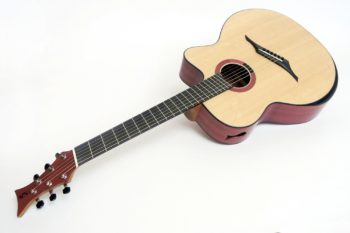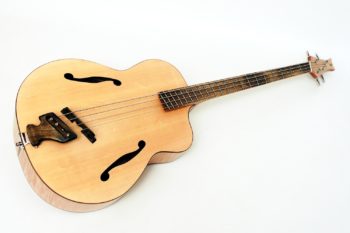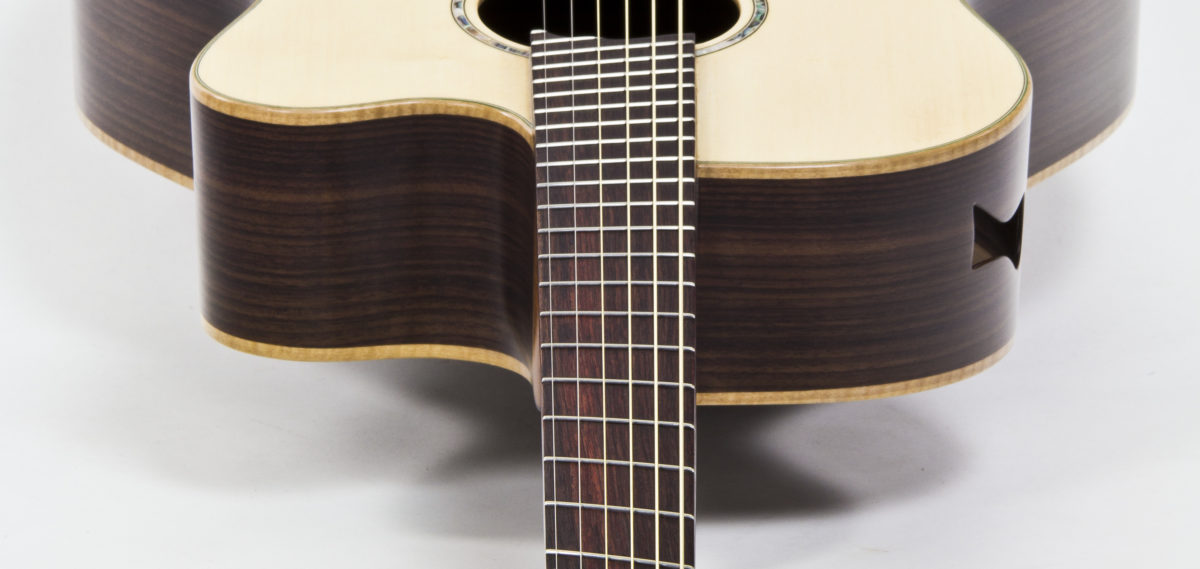
The idea behind the principle of fanned frets is to provide each string the optimal length (freely vibrating string length). The lower the sound, the more space is needed by the string, with treble notes strings may be correspondingly shorter.
In practice, this results in an instrument, where each string has a different scale length. Which is why it is also called multiscale.
The consequence of the different string lengths is the individual distribution of the frets over the entire vibrating string. This creates the characteristic fan shape.
Pythagoras' Insights Regarding String Mass, String Tension and Scale Length
- With a constant string mass and tension, the pitch changes proportionally to the length of the vibrating string. If, for example, the vibrating string length is halved, the frequency doubles and the tone sounds one octave higher.
- If the string mass and string length remain constant and the tension is changed, the pitch changes proportionally to the square root of the tension change. In order to double the frequency, the string tension must therefore be quadrupled (square root of 4 = 2).
- It is inversely proportional, if string length and tension remain the same and the string mass is altered. Quadrupling the mass results the halved frequency. The tone sounds one octave lower.
The first plucked instrument, which took this idea into account, was the harpsichord, which was developed in the fifteenth century. The strings are mounted to an asymmetrical frame and on keystroke plucked by the keel of a goose feather.
As early as the 16th century the English instrument maker John Rose developed the Orpheoreon as a member of the Citternfamily. This instrument was strung with eight or nine string pairs. A scale length of up to 70 cm expands the sound spectrum for the bass section.
In order to balance the differences in sound and response between bass and treble, he adjusted the length of the strings to build the first fretted multiscale instruments.
A first patent was filed in 1900 - also in England. Protected by this patent were musical instruments with a sound box and a neck with a curved fingerboard, where the frets are fanned out in such a way that the length of the string is larger in the bass range than in the treble range.
In the present, the Scottish classical guitarist Paul Galbraith, together with the English guitar builder David Rubio, developed an eight-string guitar, since the range of the six-string guitar did not satisfy him. In order to optimise it tonically and ergonomically, a fretboard with fanned frets was also used.
At the same time, the American guitar builder Ralph Novak dealt intensively with the subject, then in 1989 he also registered a patent for his „Novax fanned frets“.

The fact that bass builders first took up the multiscale principle and thus went into serial production is explained by the fact that the problem with the 5- or 6-string bass with low b-string is particularly noticeable. For normal bass measures, the low b-string is usually too poor sounding and not well defined. Attempts with a longer scale length improved the sound of the B-string, but on the other hand worsened the sound of the D- and G-string and made the instruments more difficult to play.
Advantages
However, a much improved sound of the low B-string with electrical and acoustic basses is by no means the only improvement to be highlighted.

The fingerboard allows the string tension to give a comfortable feel over the entire width of the fingerboard as well as the response of the individual notes is uniform over the entire length of the fingerboard. This results in an open sound with a very clean intonation. False-sounding overtones are eliminated. Open or alternative tunings can be implemented with better sound output, resulting in an increased pitch range.
Last but not least, it is the overall sound of the instrument which, by the use of different string lengths, is given greater homogeneity with a clear bass reproduction. For good reason design principle of the concert harp or the grand piano is based on string lengths which are chosen depending on the pitch.

Stoll Fanned Frets
Our multiscale instruments are fanned with the eighth fret applied in the traditional way horizontally to the fingerboard and thus forming the center point. From there the frets are fanned in both directions. This way, the fretting hand can reach all positions of the fretboard in a relaxed way. The hand no longer has to be moved parallel to the frets, but can make a natural semicircular movement.
Our IQ Akustikbass is available with four, five and six strings.
The IQ Bass Ukulele is the powerful alternative to IQ Akustikbass.
IQ Steelstring features an ergonomic arm rest (bevel) as well as a side sound port in addition to the multiscale fretboard.
The Classic Bass is also available with IQ features as bevel and fanned frets.
Of course fanned frets are an option with every custom built guitar:


